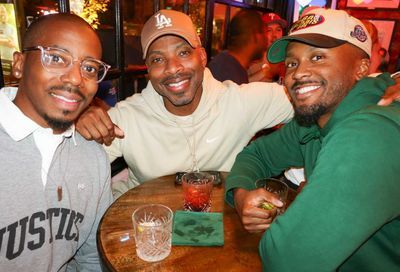Towering Timothy
Louis Bayard deconstructs the myth of Tiny Tim in 'Mr. Timothy'
There are ghosts in Mr. Timothy‘s London. Whereas in Charles Dickens’ classic A Christmas Carol the three ghosts had obvious tasks, here they are both more obscure and more worldly. They jump from body to body and face to face, haunting the all grown-up (“nearly five-eight “) tiny Tim Cratchit and offering glimpses into a world much darker, and more accessible, than Dickens’ version of London’s foggy, soot-stained streets.
The ghosts, wordplay and references of Louis Bayard’s Mr. Timothy bubble together merrily, a delicious Christmas recipe and delightful winter read. The novel benefits from a brilliant starting point of an idea, a richly evocative setting, a panoply of hilarious, menacing, and heartbreaking characters, and two brilliant authors, one working at the absolute top of his game.
The idea: Tiny Tim Cratchit, all grown up and, essentially, fighting crime. The setting: Victorian London’s grimy, fog-shrouded streets — a city that resounds in our collective consciousness even as it tilts toward the tidal, over-stuffed Thames. The story: A young man, struggling to find himself, to understand his world, and to unravel a shocking, earthy mystery involving lost girls, cryptic symbols and terrifying dreams.
Mr. Timothy rings with a cartwheeling, first person, freestyle prose. Bayard peppers the novel with linguistic playfulness and an expert’s awareness of Dickens’ literary oeuvre. “Uncle N ” (nee Uncle Neezer, nee Ebenezeer, nee Scrooge) is Tim’s earnest benefactor, but despite this, Tim has grown into an angry young man, rejecting family and support, and living in a brothel where he teaches the madam to read. Names are ripely Dickensian: the indispensable Colin the Melodius, Mr. Squidgy, Captain Gully, and Philomena Rotunno, the novel’s key “lost girl ” — a ratty vision of abandoned aristocracy with a trailing blue muffler and a perfectly coiled red ribbon in her hair.
Advertisement
|
The novel begins on December 12, 1860 and culminates on Christmas Day. It is a play on the Victorian murder/suspense novel, a moving and emotional coming of age novel, and a comment, as was Dickens’ other great novel, on what great expectations can do to a young man. Like most Dickens’ novels, the plot of Mr. Timothy is bound to a bewildering array of wicked twists, surprises, and coincidence. A few of these revelations seem a bit forced, and some readers may find this preponderance of happy (and not so happy) coincidences overwhelming. Luckily, however, the steady pace of dead, branded girls, unexplainable recognitions, and hulking men in bowler hats will keep even the most skeptical reader turning the pages with glee. Most readers will simply relish Bayard’s experimentation with Dickens’ style and conventions, and take pleasure in figuring out the mysteries right along with Tim.
In addition to the central mystery, the novel is studded with family visits, ruminations on Tim’s history, and a series of moving letters from Tim to his deceased father. These letters — spiritual, questing, funny, and shockingly bold in their re-definition of the “Tiny Tim myth ” — give us a vital glimpse into Tim’s heart.
Family, it is clear, is key. Mr. Timothy is grounded in Tim’s past (a past we share with A Christmas Carol), and set in Tim’s present. The novelist’s goal, however, is to rescue a likeable, flawed, realistic character from the stuff of cultural myth, and to find a family and future for our Tim.
He succeeds. This novel is, beneath the gorgeous, wrought-iron traceries of its setting and literary reference, a simple, deeply emotional story of growing up, families and freedom. The story of one man, discovering himself through the greatest of tests, and finally coming into his own.
“Not so tiny any more, ” the novel opens. Not so tiny an accomplishment, indeed. -30-
Support Metro Weekly’s Journalism
These are challenging times for news organizations. And yet it’s crucial we stay active and provide vital resources and information to both our local readers and the world. So won’t you please take a moment and consider supporting Metro Weekly with a membership? For as little as $5 a month, you can help ensure Metro Weekly magazine and MetroWeekly.com remain free, viable resources as we provide the best, most diverse, culturally-resonant LGBTQ coverage in both the D.C. region and around the world. Memberships come with exclusive perks and discounts, your own personal digital delivery of each week’s magazine (and an archive), access to our Member's Lounge when it launches this fall, and exclusive members-only items like Metro Weekly Membership Mugs and Tote Bags! Check out all our membership levels here and please join us today!



















